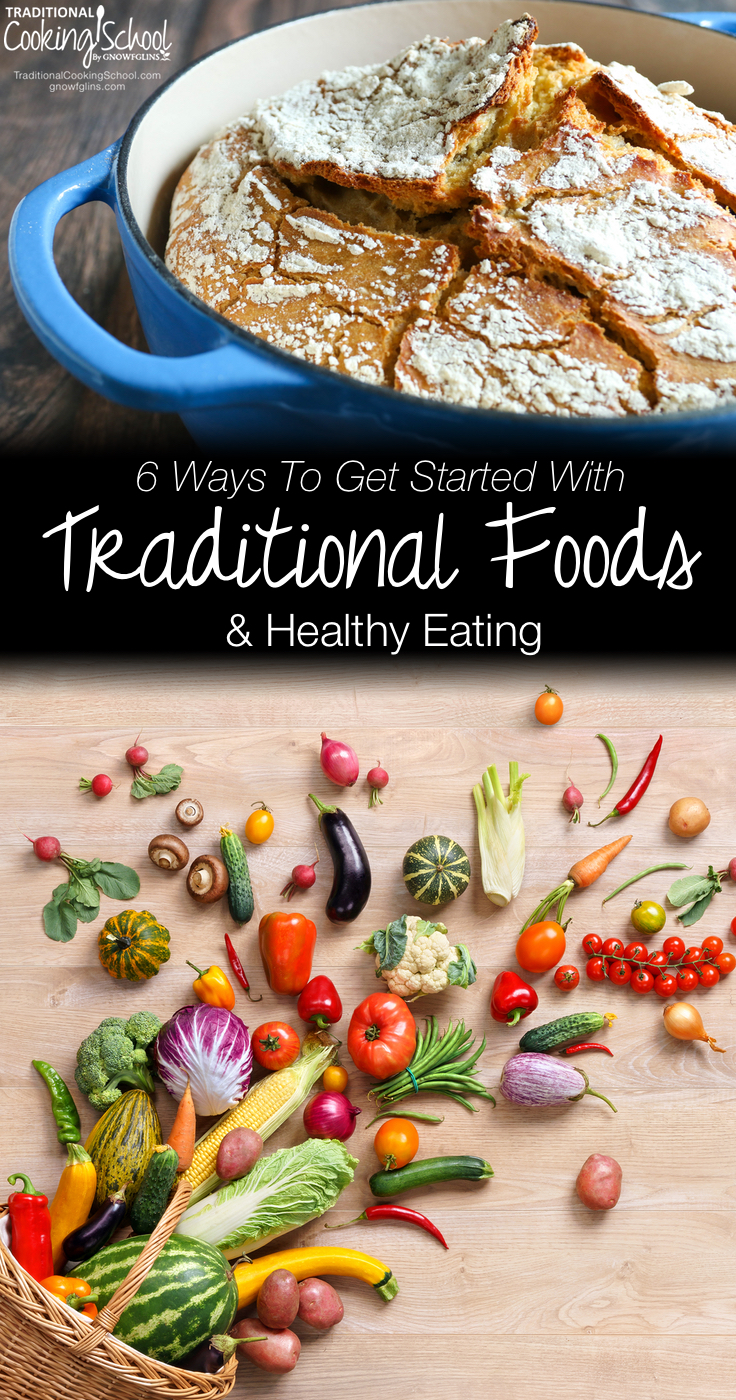
Back in the ’70s, I headed to 1st grade every morning with raw milk in my Betsy Clark thermos…
My mother might not have known what lacto-fermentation was, but she understood the value of raw milk, even in those days!
In fact, although our healthy eating habits wavered from time to time, the underlying principles remained the same:
- Food should be fresh and processed as little as possible.
- Meals should be cooked from scratch, and eaten together as a family, sitting down.
I carried these convictions into my own home when I got married. Although we couldn’t always afford organic, I baked all of our own bread and we ate fresh salads and legumes.
Then… My husband and I began to experience health issues — and a friend introduced us to “traditional foods”.
Kombucha? Fermented foods? Soaking?
I was fascinated as soon as I cracked the book, Nourishing Traditions! Yet also overwhelmed…
I needed to do sourdough on top of baking my own bread? And soak and dehydrate my nuts? And ferment my veggies?
All of this on top of keeping a home and garden running smoothly! I didn’t even know how to correctly pronounce kombucha! 😉
As the new year begins, many of us want to make a fresh start with our diets. However, plunging headlong into something as multi-faceted and time-consuming as traditional food preparation can lead to overwhelm and burnout. Traditional foods are so worth it, but sometimes we need help.
So let’s break this goal down into smaller bites. Here are 6 ways to get started with traditional foods and healthy eating!
1. Focus on 1 area at a time.
Pick 1 traditional foods skill that excites you. Do you like sourdough? Would your family enjoy water kefir — a natural fermented soda? Or maybe you would like to learn how to sprout your beans to optimize digestion (no more gas and bloating!).
What is 1 skill that you can fit into your busy life — right now?
Learn that new technique and master it, then move onto another!
Need some help mastering those skills? Sourdough baking, pressure cooking, dehydrating, and allergy-free cooking don’t always come easily. That’s why Traditional Cooking School offers eCourses to teach you these skills and more! From the basic fundamentals of traditional cooking (like fermentation, soaking, and sprouting) to more advanced sourdough baking and everything between, check out the eCourses through our membership area.
2. Learn to shop wisely.
Maybe you can’t afford to buy organic foods all the time. That’s okay! Just learn how to be choosy at the grocery store.
If you’re not familiar with the “dirty dozen“, these are the top 12 fruits and veggies most contaminated with pesticides. Even if you can’t buy organic everything, either choose to go organic with these, grow them yourself (see #3), or cut them out of your diet.
Alternatively, check out the “clean fifteen” list to see what produce is generally safe to buy non-organic.
Also educate yourself on the top GMO foods so you can avoid them or buy organic. These foods include corn, soy, sugar from sugar beets, aspartame, papayas, canola oil, cotton oil, dairy, yellow squash, and zucchini. (For more info, check out the Genetic Roulette movie.)
3. Grow some foods yourself.
My life changed the day I planted my first vegetable garden! Is there anything more gratifying than planting seeds, watching them grow, harvesting them, and enjoying the bounty of a homegrown crop for dinner?
Growing your own food can be less expensive than buying it organic at the grocery store. At the very least, you know exactly what’s gone into it.
If this seems overwhelming to you, maybe just pick some herbs to grow on your windowsill. Remember, baby steps!
For a few fun projects, see How to Grow Mint from Cuttings {2 Methods} and How to Grow Your Own Herbs for Tea {even in a small space!}.
4. Outsource.
If you can’t raise or grow it yourself, find someone who can! We have easy access to a dairy that provides raw milk from grass-fed cows. This allows me to focus my time and energy on gardening and learning how to raise chickens.
Maybe you already bake amazing bread — see if you can swap it for eggs or honey from another local farmer!
5. Keep to the 80/20 rule.
Unless you’re dealing with food allergies, focus on making 80% of your food choices at home healthy ones. Then you don’t have to worry about the occasional eating out, or being invited over for dinner.
6. Finally, be gentle on yourself.
If a week comes along and you’re too busy to soak your muffins, or sprout your beans for soup, it’s okay! Cut yourself some slack.
How do you take baby steps to incorporate traditional foods and healthy eating into your diet? How did you get started with traditional foods and healthy eating?
This post was featured in 82 Ways To Heal Your Gut.
...without giving up the foods you love or spending all day in the kitchen!

2 free books:
Eat God's Way
Ditch the Standard American Diet, get healthier & happier, and save money on groceries...
We only recommend products and services we wholeheartedly endorse. This post may contain special links through which we earn a small commission if you make a purchase (though your price is the same).


I especially like tip number one. It’s important to take it slowly. Changing your entire diet can be so difficult if we try to be perfect from the start. Thanks for sharing this article!
Amber – http://www.herbalacademyofne.com
Wonderful! Perfect advice for anyone! I shared all over the place with my followers!
Thank you Tessa!
Making changes can be so overwhelming. Your advice to take it one step at a time is wise!
Great tips! We got started on a traditional foods diet about a decade ago, and my husband went hog-wild! Everything in our house, it seemed, was fermented!
These days, with two young kids, we empahsisze organic and local foods, but still enjoy our lacto-ferments and sourdough.
Thanks for such a clear, inspirational message!
Sourdough is next on my list…next week in fact.
Wow. Lots of information to absorb. I’ll have to bookmark this to read multiple times. we really want to start eating healthier in the new year. Thanks for the inspiration!
Good luck Patrick!
I love this Jennifer!!! Nourishing Traditions was super overwhelming to me too when I started reading it, but I love your tips to make smaller goals and focusing on one area at a time. I can’t wait to follow along on your journey and hopefully make some changes ourselves. 🙂
Thank you Mary! 🙂
My question is about kombucha…..if it is made with normal tea bags, it is full of caffeine right?
I am trying to figure out how drinking sugar (even if it is organic) and caffeine is actually healthy for a person.
Can diabetic persons drink it safely?
Thanks and blessings!
Hi Susie,
Although I drink kombucha regularly without any problems I can understand your concerns about the caffeine. There are a few ways you can address this. One is to use a different kind of tea that has less caffeine such as white or green tea. If you prefer black tea, you can reportedly pre-steep it to reduce the amount of caffeine. Steep the tea bags in boiling water for 30 seconds and then discard the water. Then, move the tea bags to a fresh batch of boiling water and steep as you would to prepare the kombucha.
While you do need to use sugar in order to prepare kombucha, the sugar is consumed by the bacteria and the yeast. The longer you allow the kombucha to ferment, the more sugar is consumed. The final result contains a lot less sugar than what was originally used to prepare it.
As far as it being safe for diabetics to drink: I would not be able to give you any guidance on that. That would be something you would have to address with your health care provider.
I hope that is helpful to you!